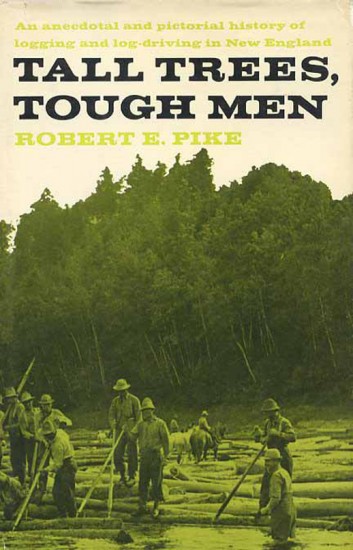
Tall Trees, Tough Men by Robert E. Pike (New York: W.W. Norton, 1967).
Chosen for the Caught by the River Nature Book Reader by James Fox.
Nineteenth and twentieth-century descriptions from amalgam of sources (first person experience and interviews) all detailing lumber camps and forestry work in the woods of New England. Historic figures and the everyman logger described. Evidently many obstacles overcome by brute force or chaw of tobacco applied. Glossary of terms at back. Self-described as a “vivid, anecdotal history of logging and log-driving in New England.” Essential reading. 320 pages.
I am not an academic on this subject of logging, but hopefully an enlightened enthusiast and this a favourite book. On one hand it is a cracking historical description of the axe lore, river drives, logjams (subsequent dynamiting), and raucous spending habits of the woodsmen of the American Northeast, but it also serves to explain the temperament of the frugal, dry-humored and hardy Yankee.
Anyone who has every chopped or stacked wood can enjoy this book. If you have every walked in the woods or enjoy winter weather you will love it. You like to wade around in water up to your waist, pushing rotten ice out of the way don’t you? It really boggles the mind to look at the photos and read stories of the logs clogging spring’s run-off and the “drivers” riding along down the river with them. There are recipes from the camp cook for bread and beans, as well as instruction on how to cruise (measure board feet) for timber. I probably read this once a year.
Further reading:
Robert E. Pike, Spiked Boots. 22 short stories told using the literary mechanism of visits with an aged logger.
Max C. Hilton, Woodsmen, Horses, and Dynamite: Rough Pulpwood Operating in Northwestern Maine, 1935-1940. Includes figures for amounts of food, horses, men, hours, and dynamite needed in a year long logging operation. Starts at the cruising or walking of the wood lot in summer and ends at the sawmill after the log drive. Ends with 63 illustrations of equipment, by the author, in style reminiscent of Eric Sloane.
James Fox spent his early life shuttling between the Green Mountains of Vermont and the rolling hills of the Scotland Borders. From that upbringing came an appreciation for thrift-store American workwear as well as John Buchan and tweed. He worked for London’s first Wagamama then in full tuxedo for a French chef on the island of Nantucket off Cape Cod, Massachusetts. Hi/low style sums up the tone of his family/food/literary/vintage blog 10engines.